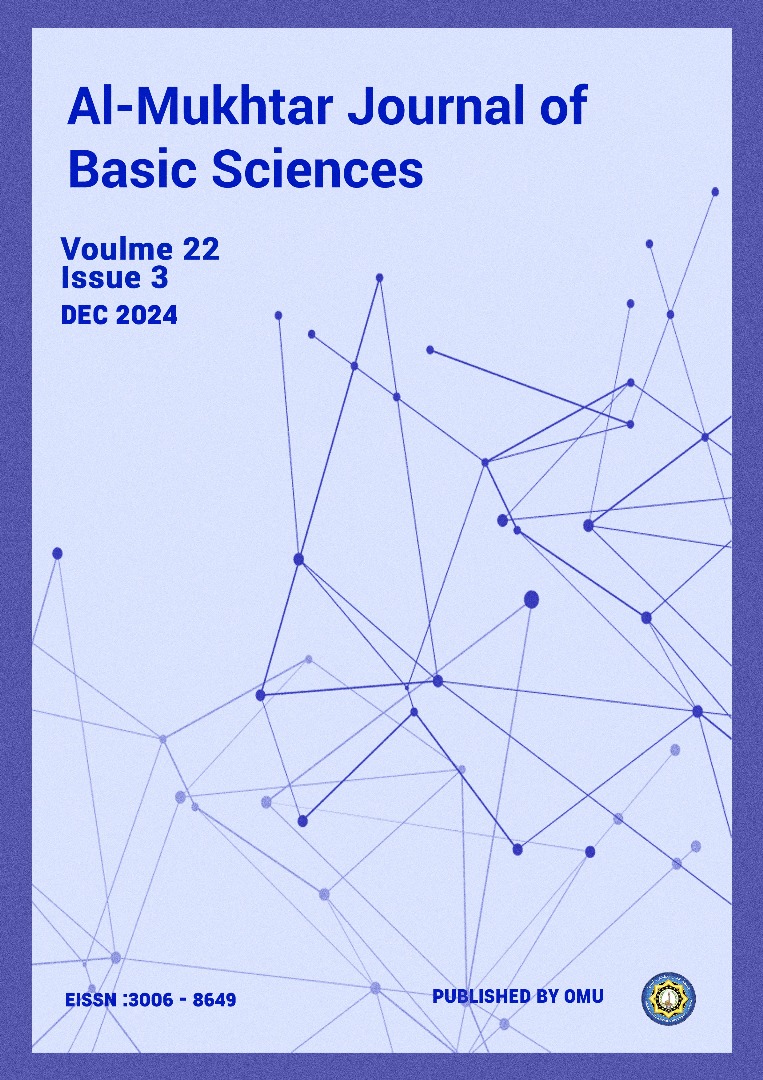Exploring the Impact of Pipe Material and Environmental Conditions on the Bacterial Adhesion to the Surface of the Drinking Water Distribution System
DOI:
https://doi.org/10.54172/168r0808Keywords:
Polyvinyl Chloride (PVC), Galvanized Iron, Bacterial Adhesion, Biofilm Formation, Water Distribution Systems, Colony forming units (CFUs)Abstract
Bacterial adhesion to surfaces is a complicated process influenced by several factors. Key factors are the physical properties of the materials, characteristics of the bacteria, and environmental conditions. In this study, the effects of the type of water distribution pipe material, water temperature, water flow speed, and contact time on the rate of bacterial adhesion to the pipe walls were evaluated. Two species of bacteria, gram-negative and gram-positive, were selected to study their tendency to adhere to the surfaces of two types of materials (galvanized iron and Polyvinyl Chloride (PVC)) used in the manufacture of water distribution pipes. The results showed that elevated temperature and contact time contributed to Increased adhesion of Gram positive bacteria to galvanized iron, whereas no discernible effects were observed for Gram negative bacteria. These findings also demonstrated that positively charged bacteria exhibited a higher capacity to adhere to mutually galvanized iron and PVC surfaces than Gram negative bacteria. Moreover, the rate of adhesion of Gram positive bacteria increased with increasing water flow rate, and there was no clear effect of water flow rate on the extent of adhesion of Gram negative bacteria on both surfaces. This study underscores the necessity of selecting appropriate pipe materials, factoring in operational temperatures and water flow dynamics to effectively manage bacterial biofilm development in distribution systems.
References
Adelodun B, Ajibade FO, Ighalo JO, Odey G, Ibrahim RG, Kareem KY, Bakare HO, Tiamiyu AO, Ajibade TF, Abdulkadir TS, Adeniran KA, Choi KS (2021) Assessment of socioeconomic inequality based on virus-contaminated water usage in developing countries: A review. Environmental research 192, 110309. https://doi.org/10.1016/j.envres.2020.110309 .
Bain R, Cronk R, Wright J, Yang H, Slaymaker T, Bartram J (2014) Fecal Contamination of Drinking-Water in Low- and Middle-Income Countries: A Systematic Review and Meta-Analysis. PLoS Medicine, 11, 1–23. https://doi.org/10.1371/journal.pmed.1001644 .
Bohinc K, Jevšnik M, Nipič D, Dražić G, Abram A, Jeršek B, Kurinčič M, Raspor P (2016) Metal surface characteristics dictate bacterial adhesion capacity. International Journal of Adhesion and Adhesives, 68, 39-46–46. https://doi.org/10.1016/j.ijadhadh.2016.01.008 .
Chambless JD, Stewart PS (2007) A three-dimensional computer model analysis of three hypothetical biofilm detachment mechanisms. Biotechnology and bioengineering, 97, 1573–1584. https://doi.org/10.1002/bit.21363 .
Chen H, Wei Z, Sun G, Hu B, Lou L, Su H, Liu J, Zhou X (2020) Formation of biofilms from new pipelines at both ends of the drinking water distribution system and comparison of disinfection by-products formation potential. Environmental Research, 182, 109150. https://doi.org/10.1016/j.envres.2020.109150 .
Chik N, Wan Md Zain WS, Wan Ibrahim WH, Mohamad AJ, Sidek MZ, Reif A, Rakebrandt, JH, Pfleging W, Liu X (2018) Bacterial Adhesion on the Titanium and Stainless-Steel Surfaces Undergone Two Different Treatment Methods: Polishing and Ultrafast Laser Treatment. IOP Conference Series: Materials Science and Engineering, 358, 012034. https://doi.org/10.1088/1757-899X/358/1/012034 .
Christersson CE, Glantz PJ, Baier RE (1988) Role of temperature and shear forces on microbial detachment. European Journal of Oral Sciences, 96, 91–98. https://doi.org/10.1111/j.1600-0722.1988.tb01413.x .
Costerton JW, Lewandowski Z, Caldwell DE, Korber DR, Lappin-Scott H (1995) Microbial biofilms. Annual review of microbiology, 49, 711–745. https://doi.org/10.1146/annurev.mi.49.100195.003431 .
da Silva Malheiros P, dos Passos CT, Casarin LS, Serraglio L, Tondo EC (2010) Evaluation of growth and transfer of Staphylococcus aureus from poultry meat to surfaces of stainless steel and polyethylene and their disinfection. Food Control, 21, 298–301. https://doi.org/10.1016/j.foodcont.2009.06.008 .
Da Silva Meira QG, De Medeiros Barbosa I, Alves Aguiar Athayde AJ, De Siqueira-Júnior, JP, De Souza EL (2012) Influence of temperature and surface kind on biofilm formation by Staphylococcus aureus from food-contact surfaces and sensitivity to sanitizers. Food Control, 25, 469–475. https://doi.org/10.1016/j.foodcont.2011.11.030 .
Danchik C, Casadevall A (2021) Role of Cell Surface Hydrophobicity in the Pathogenesis of Medically-Significant Fungi. Frontiers in Cellular and Infection Microbiology, 10, 594973 https://doi.org/10.3389/fcimb.2020.594973 .
Doyle RJ (2000) Contribution of the hydrophobic effect to microbial infection. Microbes and Infection, 2, 391–400. https://doi.org/10.1016/S1286-4579(00)00328-2 .
Erdei-Tombor P, Kiskó G, Taczman-Brückner A (2024) Biofilm Formation in Water Distribution Systems. Processes, 12(2), 280. https://doi.org/10.3390/pr12020280 .
Fink R, Oder M, Rangus D, Raspor P, Bohinc K (2015) Microbial adhesion capacity. Influence of shear and temperature stress. International Journal of Environmental Health Research, 25, 656–669. https://doi.org/10.1080/09603123.2015.1007840 .
Fletcher M (1977) The effects of culture concentration and age, time, and temperature on bacterial attachment to polystyrene. Canadian Journal of Microbiology, 23, 1–6. https://doi.org/10.1139/m77-001 .
Fulaz S, Vitale S, Quinn L, Casey E (2019) Nanoparticle–Biofilm Interactions: The Role of the EPS Matrix. Trends in Microbiology, 27, 915–926. https://doi.org/10.1016/j.tim.2019.07.004 .
Goldberg J (2002) Biofilms and antibiotic resistance: a genetic linkage. TRENDS in Microbiology, 10, 264. https://doi.org/10.1016/S0966-842X(02)02381-8
Gomez CK, Aggarwal S (2019) Overview of Drinking Water Distribution System Microbiome and Water Quality. Encyclopedia of Water, 1–17. https://doi.org/10.1002/9781119300762.wsts019 .
Goraj W, Pytlak A, Kowalska B, Kowalski D, Grządziel J, Szafranek-Nakonieczna A, Gałązka A, Stępniewska Z, Stępniewski W (2021) Influence of pipe material on biofilm microbial communities found in drinking water supply system. Environmental research, 196, 110433. https://doi.org/10.1016/j.envres.2020.110433 .
Katsikogianni M, Missirlis YF (2004) Concise review of mechanisms of bacterial adhesion to biomaterials and of techniques used in estimating bacteria-material interactions. European Cells & Materials, 8, 37–57.
Kerr CJ, Osborn KS, Robson GD, Handley PS (1998) The relationship between pipe material and biofilm formation in a laboratory model system. Journal of Applied Microbiology, 85, 29S. https://doi-org.portal.lib.fit.edu/10.1111/j.1365-2672.1998.tb05280.x .
Learbuch KLG, Smidt H, van der Wielen PWJJ (2021) Influence of pipe materials on the microbial community in unchlorinated drinking water and biofilm. Water Research, 194, 116922. https://doi.org/10.1016/j.watres.2021.116922 .
Liu Q, Li R, Qu W, Tian X, Zhang Y, Wang W (2023) Influence of surface properties on the adhesion of bacteria onto different casings. Food Research International, 164, 112463. https://doi.org/10.1016/j.foodres.2023.112463 .
Liu Y, Tay JH (2002) The essential role of hydrodynamic shear force in the formation of biofilm and granular sludge. Water research, 36, 1653–1665. https://doi.org/10.1016/s0043-1354(01)00379-7 .
Lorenzetti M, Dogša I, Stošicki T, Stopar D, Kalin M, Kobe S, Novak S (2014) The Influence of Surface Modification on Bacterial Adhesion to Titanium-Based Substrates. ACS Applied Materials & Interfaces, 7, 1644–1651. https://doi.org/10.1021/am507148n .
Meylheuc T, Bellon-Fontaine MN, Van Oss CJ (2001) Adsorption of biosurfactant on solid surfaces and consequences regarding the bioadhesion of Listeria monocytogenes LO28. Journal of Applied Microbiology, 91, 822–832. https://doi.org/10.1046/j.1365-2672.2001.01455.x.
Morisaki H (1991) Measurement of the force necessary for removal of bacterial cells from a quartz plate. Journal of General Microbiology, 137, 2649–2655. https://doi.org/10.1099/00221287-137-11-2649.
Niquette P, Servais P, Savoir R (2000) Impacts of pipe materials on densities of fixed bacterial biomass in a drinking water distribution system. Water Research, 34, 1952–1956. https://doi.org/10.1016/S0043-1354(99)00307-3 .
Oder M, Kompare B, Bohinc K, Torkar KG (2015) The impact of material surface roughness and temperature on the adhesion of Legionella pneumophila to contact surfaces. International Journal of Environmental Health Research, 25, 469–479. https://doi.org/10.1080/09603123.2014.963035.
Oh JK, Yegin Y, Yang F, Zhang M, Li J, Huang S, Verkhoturov SV, Schweikert, EA, Perez-Lewis K, Scholar EA, Taylor TM, Castillo A, Cisneros-Zevallos L, Min Y, Akbulut M (2018) The influence of surface chemistry on the kinetics and thermodynamics of bacterial adhesion. Scientific Reports, 8, 17247. https://doi.org/10.1038/s41598-018-35343-1
Owens CEL, Angles ML, Cox PT, Byleveld PM, Osborne NJ, Rahman MB (2020) Implementation of quantitative microbial risk assessment (QMRA) for public drinking water supplies: Systematic review. Water research, 174, 115614. https://doi.org/10.1016/j.watres.2020.115614
Paray, A. A., Singh, M., Mir, M., & Kaur, A (2023) Gram staining: a brief review. Int J Res Rev, 10, 336–341. https://doi.org/10.52403/ijrr.20230934 .
Peng JS, Chou CC, Tsai WC (2002) Inactivation and removal of Bacillus cereus by sanitizer and detergent. International Journal of Food Microbiology, 77, 11–18. https://doi.org/10.1016/S0168-1605(02)00060-0 .
Reyes CD, García AJ (2003) A centrifugation cell adhesion assay for high-throughput screening of biomaterial surfaces. Journal of Biomedical Materials Research - Part A, 67, 328–333. https://doi.org/10.1002/jbm.a.10122 .
Rhoads WJ, Bradley TN, Mantha A, Buttling L, Keane T, Pruden A, Edwards MA (2020). Residential water heater cleaning and occurrence of Legionella in Flint, MI. Water Research, 171, 115439. https://doi.org/10.1016/j.watres.2019.115439.
Rode TM, Langsrud S, Holck A, Moretro T (2007) Different patterns of biofilm formation in Staphylococcus aureus under food-related stress conditions. International journal of food microbiology, 116, 372–383.
Roosjen A, Busscher HJ, Norde W, Van der Mei HC (2006) Bacterial factors influencing adhesion of Pseudomonas aeruginosa strains to a poly(ethylene oxide) brush. Microbiology, 152, 2673–2682. https://doi.org/10.1099/mic.0.29005-0.
Roy PK, Ha AJ, Mizan MFR, Hossain MI, Ashrafudoulla M, Toushik SH, Nahar S, Kim Y K, Ha SD (2021) Effects of environmental conditions (temperature, pH, and glucose) on biofilm formation of Salmonella enterica serotype Kentucky and virulence gene expression. Poultry Science, 100, 101209. https://doi.org/10.1016/j.psj.2021.101209.
Schwering M, Song J, Turner RJ, Ceri H, Louie M (2013) Multi-species biofilms defined from drinking water microorganisms provide increased protection against chlorine disinfection. Biofouling, 29,917–928. https://doi.org/10.1080/08927014.2013.816298 .
Senevirathne SWMAI, Mathew A, Toh YC, Yarlagadda PKDV (2022) Bactericidal Efficacy of Nanostructured Surfaces Increases under Flow Conditions. ACS Omega, 7, 41711–41722. https://doi.org/10.1021/acsomega.2c05828.
Sharma S, Mohler J, Mahajan SD, Schwartz SA, Bruggemann L, Aalinkeel R (2023) Microbial Biofilm: A Review on Formation, Infection, Antibiotic Resistance, Control Measures, and Innovative Treatment. Microorganisms, 11, 1614. https://doi.org/10.3390/microorganisms11061614.
Stefan DS, Bosomoiu M, Teodorescu G (2023) The Behavior of Polymeric Pipes in Drinking Water Distribution System—Comparison with Other Pipe Materials. Polymers, 15, 3872. https://doi.org/10.3390/polym15193872.
Waqas U, Farhan A, Haider A, Qumar U, Raza A (2023) Advancements in biofilm formation and control in potable water distribution systems: A comprehensive review and analysis of chloramine decay in water systems. Journal of Environmental Chemical Engineering, 11, N.PAG. https://doi.org/10.1016/j.jece.2023.111377.
Yoda I, Koseki H, Tomita M, Shida T, Horiuchi H, Sakoda H, Osaki M (2014) Effect of surface roughness of biomaterials on Staphylococcus epidermidis adhesion. BMC microbiology, 14, 234. https://doi.org/10.1186/s12866-014-0234-2 .
Zeraik AE, Nitschke M (2012) Influence of growth media and temperature on bacterial adhesion to polystyrene surfaces. Brazilian Archives of Biology and Technology 55, 569–576. https://doi.org/10.1590/S1516-89132012000400012 .
Zhang J, Li W, Chen J, Qi W, Wang F, Zhou Y (2018) Impact of biofilm formation and detachment on the transmission of bacterial antibiotic resistance in drinking water distribution systems. Chemosphere, 203, 368–380. https://doi.org/10.1016/j.chemosphere.2018.03.143 .
Zhang X, Lin T, Jiang F, Zhang X, Wang S, Zhang S (2022) Impact of pipe material and chlorination on the biofilm structure and microbial communities. Chemosphere, 289, 133218. https://doi.org/10.1016/j.chemosphere.2021.133218 .
Zhu Z, Wu C, Zhong D, Yuan Y, Shan L, Zhang J (2014) Effects of Pipe Materials on Chlorine-resistant Biofilm Formation Under Long-term High Chlorine Level. Applied Biochemistry and Biotechnology: Part A: Enzyme Engineering and Biotechnology, 173, 1564–1578. https://doi.org/10.1007/s12010-014-0935-x .
Downloads
Published
Issue
Section
License
Copyright (c) 2024 Anad M. Alshaybani, Ebtesam Abdulhadi , Abdallah I. Abdallah , Hanin Bzizi (Author)

This work is licensed under a Creative Commons Attribution-NonCommercial 4.0 International License.
Copyright of the articles Published by Al-Mukhtar Journal of Basic Sciences (MJBS) is retained by the author(s), who grant MJBS a license to publish the article. Authors also grant any third party the right to use the article freely as long as its integrity is maintained and its original authors and cite MJSc as the original publisher. Also, they accept the article remains published by the MJBS website (except in the occasion of a retraction of the article).












